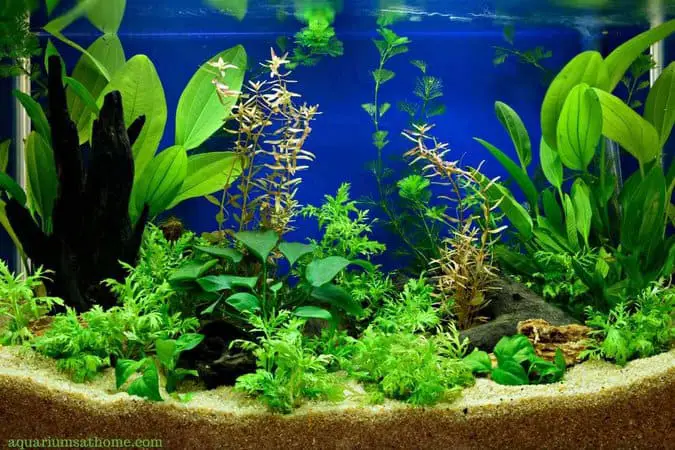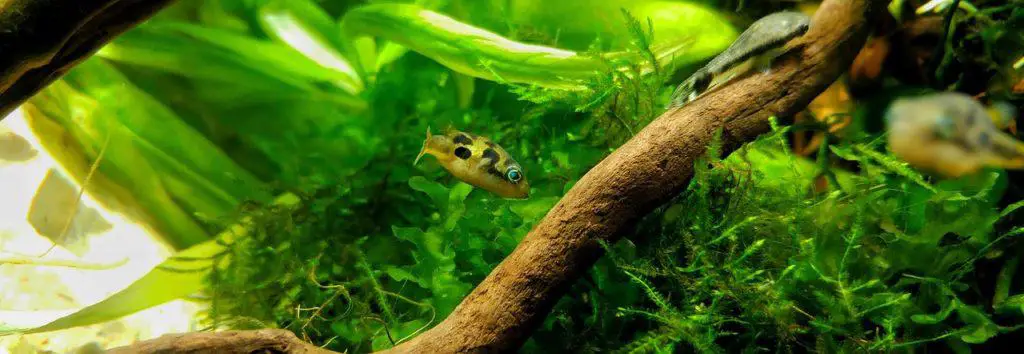Live plants in an aquarium not only create a more natural habitat for fish, but they also help oxygenate the environment. Real greenery removes harmful carbon dioxide from tank water while providing an additional food source for fish. The question remains, how do you clean live aquarium plants safely?
Cleaning live aquarium plants isn’t as easy as cleaning artificial or silk plants since they’re more susceptible to damage. The best way to remove debris is to gently remove the particles with a soft cloth or toothbrush while the plants remain in place in the tank so as not to disturb the roots.
Now that you know it’s best to clean live aquarium plants without moving them, let’s explore this idea further and in more detail. Together we’ll learn why live plants are better than fake ones, how to use a cloth or toothbrush to remove debris, if you can use salt, vinegar, baking soda, lemon juice, hydrogen peroxide, or bleach to clean real plants, how to replant greenery if you need to remove it for cleaning, and if water changes and tank equipment like filters help keep aquarium plants clean.
So, if you’re ready to ‘dive deeper’ into this topic and learn more about keeping your aquarium plants clean and healthy, then let’s begin!
Should You Remove Live Aquarium Plants to Clean Them?
Ideally, you should try not to disturb live plants in an aquarium for any reason. If you must clean them, then you should do so carefully and without uprooting them. Taking a soft washcloth or toothbrush and gently swiping away dirt and debris is the best way to prevent damaging aquarium plants.
Using a Cloth to Clean Live Aquarium Plants
Using a washcloth to clean live aquarium plants is a great way to remove debris without harming them. Begin by ensuring the cloth is free of any chemicals. Dip the cloth into the tank and swipe across the plant leaves slowly and gently until the dirt is gone. Avoid tugging or getting too close to the roots.
Use a Toothbrush to Clean Live Aquarium Plants
You can use a toothbrush to safely clean live aquarium plants. I’d recommend using a new toothbrush to prevent contaminating the tank with bacteria. Simply take the toothbrush and swipe across the leaves slowly and gently. Make sure stay away from the roots and be careful not to scrub the foliage to harshly.
Use Salt to Clean Live Aquarium Plants
You can use sodium chloride to clean live aquarium plants, but you must remove it first. Mix a cup of non-iodized salt into a gallon of distilled water and carefully dip the leaves into the mixture for no more than 30 seconds. Avoid getting the roots wet as this may damage the plant. Gently rinse the plant off with clean water before replacing it in the tank.

Using Vinegar to Clean Live Aquarium Plants
To effectively clean live aquarium plants with vinegar, begin by removing the plant from the tank. Add ½ cup of white vinegar to a gallon of distilled water and soak the leaves (not the roots) in the solution for up to 15 minutes. Gently rinse off the solution with clean water and allow the plant to dry a bit before putting it back in the tank.
Use Baking Soda to Clean Live Aquarium Plants
A baking soda bath is a good way to clean live aquarium plants. The natural solution is safe and will help prevent future fungal growth. Start by removing the plant and placing it in a solution of 1 tsp baking soda and 1 quart of water – steer clear of the roots and make sure to rinse the plant with fresh water before putting it back in the tank.
Use Lemon Juice to Clean Live Aquarium Plants
Making a paste with lemon juice and salt is one way to clean live aquarium plants. First, remove the plant from the tank. Next, combine 1 tsp non-iodized salt with 3 tsp lemon juice and mix together. Then, take a toothbrush and gently apply the paste to the plant leaves – avoid the roots. Conclude by rinsing the leaves thoroughly with warm water before placing the plant back in the tank.
Use Hydrogen Peroxide to Clean Live Aquarium Plants
You can use hydrogen peroxide to safely and effectively clean live aquarium plants. Start by removing the plant from the tank. Prepare the solution using 3% hydrogen peroxide – add 2 ml of H2O2 to a gallon of distilled water. Carefully dip the foliage (not the roots) into the solution for up to 5 minutes. Rinse the leaves completely with clean water and replace the plant into the tank.
Can You Use Bleach to Clean Live Aquarium Plants?
I wouldn’t recommend using bleach to clean live aquarium plants since the liquid is too strong for most types of aquatic flora. If you have artificial aquarium plants, you can mix 1 part bleach to 20 parts water and dip the leaves in the solution for up to 2 minutes – don’t forget to don your rubber gloves.
Before placing the plant back in the tank, you must rinse it thoroughly with a neutralizing solution made from distilled water and an aquarium dechlorinate at 3 times the suggested strength until no trace (or smell) of bleach remains. Instead, opt for a natural cleaner – it’s safer and in most cases, just as effective.
How do You Replant a Live Aquarium Plant?
Should you need to remove your aquarium foliage for cleaning, you can easily replant it. Simply place the roots back gently into the sand or gravel from where you removed it and then redistribute the substrate carefully to anchor the root.
How to Keep Live Aquarium Plants Free of Algae?
To prevent algae overgrowth on aquarium plants, make sure the light in the tank is adequate. Install a timer and/or dimmer to ensure the light isn’t too bright or on for too long. That said, if the light is too weak then aquarium plants won’t be healthy or grow to their full potential.
In general, anywhere from 6 to 8 hours of light per day is plenty for most types of aquatic plants. Avoid placing the tank in direct sunlight as this may increase the temperature in the tank to an uncomfortable level for fish, not to mention promote unsightly algae growth.
Do Tank Filters Help Keep Live Aquarium Plants Clean?
Filters go a long way in helping to keep live aquarium plants clean and healthy. They help remove dirt and debris from the water while reducing toxic ammonia. Which filter you choose will depend on the size of your tank and type of fish you keep.
Do Water Changes Help Keep Live Aquarium Plants Clean?
Water changes help keep aquarium plants clean by removing bacteria particles and organic debris that settle on live foliage. Bi-weekly partial water changes of 15-25% will also prevent algae overgrowth which can ‘dirty’ aquatic flora.
Final Thoughts
To sum-up, there are different ways to clean your real aquarium plants safely and effectively. You can use natural cleaners including salt, vinegar, or lemon juice as well as stronger solutions made with hydrogen peroxide or bleach. The method you choose will depend on how dirty the plants are and whether they’re overrun with algae, bacterial fungi, or aquatic pets such as snails or slugs.
I hope this article has been of help to you in choosing the best way to clean your live aquatic plants. Thanks for reading and good luck!






